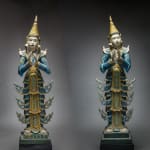Pair of Burmese Polychromed Wooden Temple Figures, 1800 CE - 1900 CE
Wood
height 121.9 cm
height 48 in
height 48 in
AM.0131
Further images
-
(View a larger image of thumbnail 1
)

-
(View a larger image of thumbnail 2
)

-
(View a larger image of thumbnail 3
)

-
(View a larger image of thumbnail 4
)

-
(View a larger image of thumbnail 5
)

-
(View a larger image of thumbnail 6
)

-
(View a larger image of thumbnail 7
)

-
(View a larger image of thumbnail 8
)

-
(View a larger image of thumbnail 9
)

-
(View a larger image of thumbnail 10
)

The Mandalay Period represents the last great cultural flourishing of Burmese art. The period was named after the city of Mandalay, which served as capital of Myanmar for a brief...
The Mandalay Period represents the last great cultural flourishing of Burmese art. The period was named after the city of Mandalay, which served as capital of Myanmar for a brief period (1860-1885 A.D.) during the reign of King Mindon. After the Anglo-Burmese Wars, northern Myanmar was shut off from the coastal areas that were controlled by the British. King Mindon founded the new capital at a sacred site at the foot of a large hill. The center of the city was designed in the perfect geometrical form of a Buddhist Mandala, giving the city its name. Although this short-lived kingdom finally fell to the British forces in 1886 A.D. during the Third Anglo-Burmese War, the Royal Guilds that created such remarkable works of art for the King remained in the city where they continued to produce sculptures in the Mandalay style.









